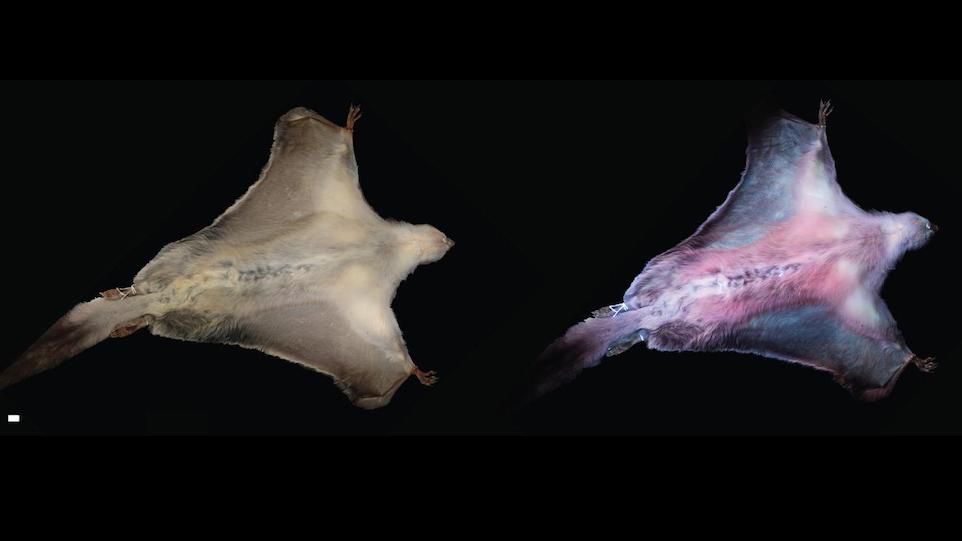
Glowing mammals

Recent discoveries highlighted that the fur of various mammal species glows in shades of pink and red when exposed to ultraviolet light. Researchers identified the molecule porphyrin as the source of this property.
05/09/2022 · News · Museum für Naturkunde - Leibniz-Institut für Evolutions- und Biodiversitätsforschung · Lebenswissenschaften · Forschungsergebnis
Recent discoveries highlighted that the fur of various mammal species glows in pretty shades of pink and red when exposed to ultraviolet (UV) light. Unravelling the cause of this unexpected phenomenon, an international collaboration lead by researchers from the Humboldt University in Berlin and the Museum für Naturkunde Berlin identified the molecule porphyrin, an organic colorant, as the source of this luminescent fur. Rather than serving an ecological function, as previously assumed, luminescent fur results from the body’s waste management of porphyrins. These findings imply that the process underlying luminescence is widespread in mammals.
Nature is extremely rich in colour. We perceive only a limited window of natural light as colour; UV light, for example, is invisible to the human eye. However, in a process known as photoluminescence, UV light can be absorbed and reemitted as a visible colour. Photoluminescence is a well-known phenomenon in invertebrate animals; scorpions, for example, emit blue light when exposed to UV. Over the last couple of years, several scientists have made exciting new observations of photoluminescence in various mammals, such as hedgehogs, flying squirrels and even in the enigmatic duck-billed platypus. Besides resulting in colourful photographs, the phenomenon sparked the interest of the scientific community and the public alike. Could this photoluminescence serve an ecological function, as often suggested?
An international collaboration, with researchers from institutions based in Germany, France, Switzerland, Sweden and Norway, attempted to unravel the mysteries of the luminescent fur. Previous studies observed photoluminescence in nocturnal mammals, but noted that closely related relatives that are active during daytime do not luminesce. These studies proposed that photoluminescence has an ecological role, for example as a way to attract mates and communicate with members of the same species, or to camouflage themselves. This new study dismisses this hypothesis, because the conditions required to generate and perceive the photoluminescence, like a concentrated beam of UV in an otherwise dark space, are unlikely to appear in nature.
Instead, the researchers tracked down the chemical origin of the photoluminescence. Collaborators at the IPANEMA lab (CNRS, France) analysed fur samples of the duck-billed platypus, opossums, hedgehogs, weasels, and flying squirrels. The collection of the Museum für Naturkunde Berlin provided at least one fur specimen representing each of these animals, except for weasels. The team found that the compounds responsible for the photoluminescence are porphyrins, stored within the hairs. They also observed a rapid loss of photoluminescence in the lab, as porphyrins rapidly break apart when exposed to sunlight. Porphyrins serve as building blocks for several vital proteins in mammalian biology, and many organs readily produce them. However, overproduction of porphyrins can lead to severe skin lesions amongst other diseases. Mammals can prevent accumulation of porphyrins by using their hair as storage, where sunlight effectively breaks down these molecules. The temporary presence of porphyrins in hair in turn causes the fur to luminesce.
Because the sampled mammals that store porphyrin in their hairs are distantly related, the scientists propose that this strategy is widespread among mammals. They thus expect more reports of luminescent mammals in the future. Moreover, this new hypothesis explains why nocturnal mammals luminesce when their diurnal relatives do not – both store porphyrins in their fur, but the breakdown is much more rapid when the sun is shining.
Original publication
Toussaint et. al (2022): Fur glowing under ultraviolet: in situ analysis of porphyrin accumulation in the skin appendages of mammals, Integrative Zoology.